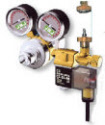 |
Floating Plants
Floating plants are great in your aquarium and have many uses. They Plants provide areas for fry to hide, help block light, and tend to be quick growers which can keep excess nutrients out of the aquarium water. By removing these excess nutrients you decrease the chance of algae taking over your fish tank or aquarium. Floating aquarium or pond plants are also usually good for ponds and watergardens as well. Some fish such as koi and goldfish may like to munch on plants such as salvinia and duckweed. Check out or huge selection of freshwater aquarium plants for sale.
